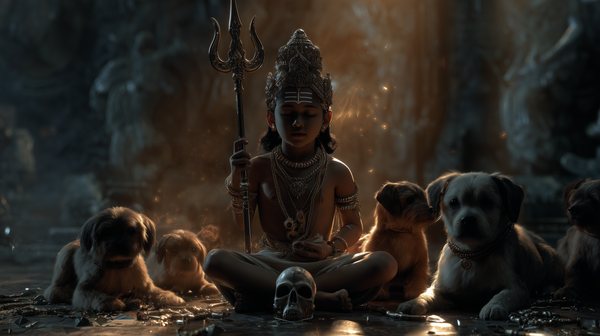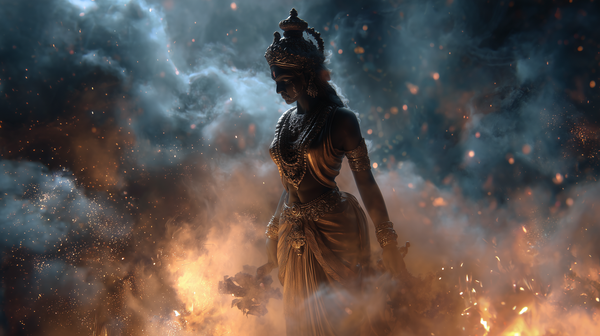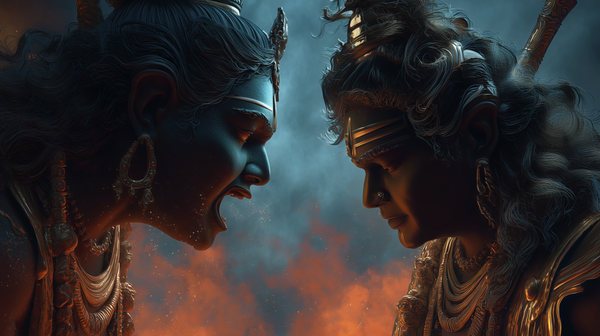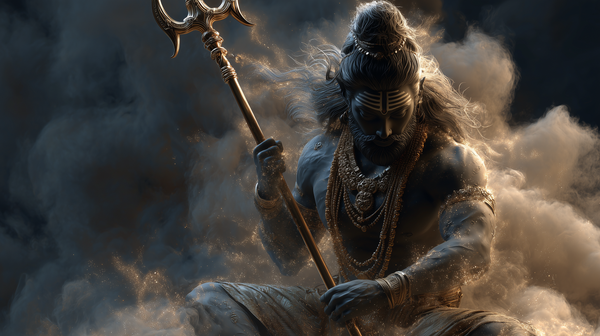Understanding the Difference Between Mahakal and Kalabhairava: A Comprehensive Guide
This lecture distinguishes between Mahakal and Kalabhairava, two profound forms of Shiva. The key difference between them is the presence of Shakti, the divine feminine energy
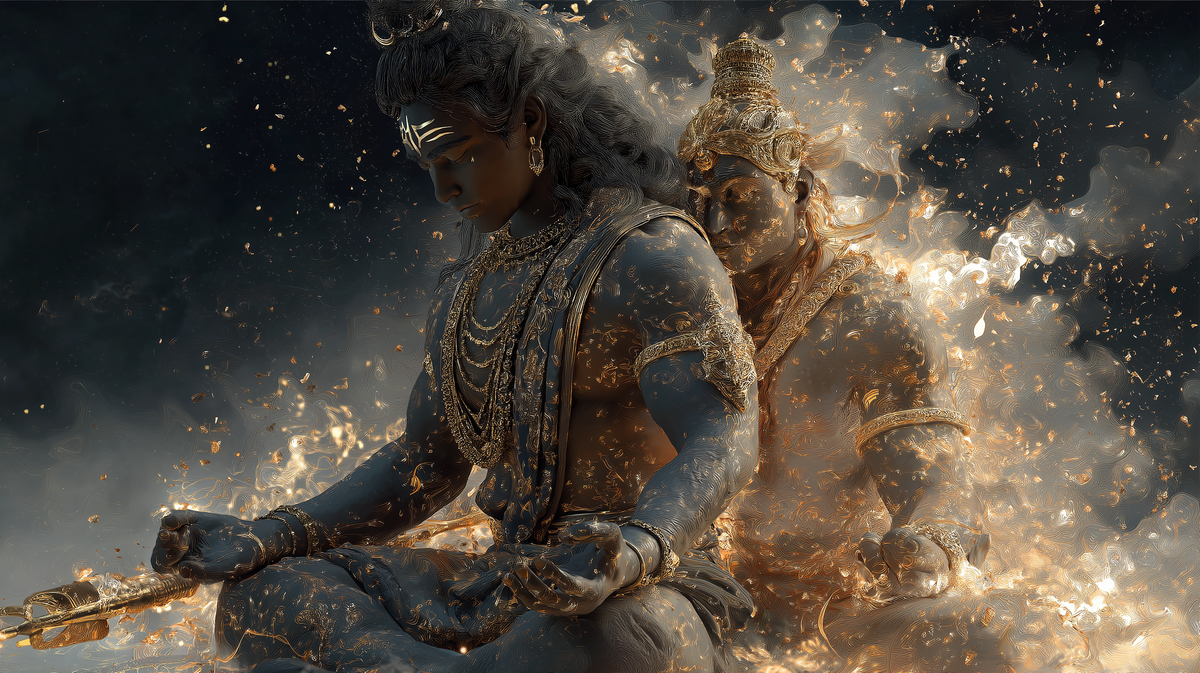
This article is derived from Guruji’s video lecture, Satsang, Praveen Radhakrishnan. All content and intellectual property rights belong to Guruji and the KaliPutra Mission
Introduction
[00:00:16] The video explores the primary difference between Mahakal and Kalabhairava, two powerful entities originating within the universe of Shiva. The speaker aims to clarify how these two manifestations of Shiva should be understood and what fundamentally distinguishes them from each other. The informal setting includes the speaker's dogs, particularly one named Beam (a Rajapalayam with a distinctive half-moon marking under his eye), adding a personal touch to this profound spiritual discussion.
The Nature of Mahakal
[00:02:50] Mahakal is described as complete latent, passive energy mass—Shiva's energy in its dormant state. As the speaker explains, "Mahakal is time itself," which is why he is called Mahakaleshwar, the complete embodiment of time. While everything in creation moves and changes—Earth rotates, days and nights pass—Mahakal remains the only constant, unmoved and unchanging.
[00:03:52] The key characteristic of Mahakal is that his Shakti (divine power) remains contained within him. He embodies Shiva as the perfect yogi: stable, sitting in meditation with eyes closed, completely unmoving and undistracted. This form represents the complete embodiment of life in its potential state, yet it does not actively engage with creation.
[00:05:27] Mahakal is described as absolutely unmovable—"you could hit him, try to move him, but nothing happens." The speaker notes that experiencing Mahakal in his Parabrahma rupam (supreme form) is not possible while in a physical body, as this form "cannot be envisioned or absorbed by the physical body." This emphasizes Mahakal's transcendent nature.
The Nature of Kalabhairava
[00:04:47] Kalabhairava, in contrast to Mahakal, is characterized by the active presence of Shakti. The speaker explains that "Kalabhairava is not just Shiva, he is also Shakti." When Kalabhairava emerges from Shiva's third eye, what manifests is the union of Shiva and Shakti, with the first Mahavidya (wisdom goddess) being Kalika/Mahakali.
[00:06:00] This union of Shiva and Shakti is what makes Kalabhairava "the most potent form of Shiva imaginable." The integration of the feminine principle of energy (Shakti) with the masculine principle of consciousness (Shiva) creates a powerful, dynamic entity that can actively engage with and transform creation.
The Essential Difference: Potential vs. Kinetic Energy
[00:09:00] The speaker uses a powerful analogy to illustrate the difference: "Mahakaal is like the biggest nuclear reactor—full of energy, but the energy is within, contained, not moving." In contrast, "Kalabhairava, when he spouts out of Shiva's third eye, is Mahakaal with Shakti—moving, not latent." This distinction between potential and kinetic energy forms the core difference between these two entities.
[00:12:30] The speaker summarizes: "Mahakaal: the great potential energy. Kalabhairava: potential energy meets Shakti and moves." This concise statement captures the essential distinction that the entire discussion revolves around.
Kalabhairava as the Supreme Guru
[00:10:42] Kalabhairava is considered the greatest Guru because he not only connects devotees to the immense potential energy of Mahakal but also embodies Shakti and guides practitioners to every form of the divine feminine. He represents the complete path to spiritual realization through both the principles of stillness and dynamism.
[00:11:31] Unlike Mahakal, who remains in meditation, Kalabhairava actively engages with devotees. He is "not just the Guru of Brahma, showing the path of enlightenment where you become a stone." Instead, he teaches practitioners "what it is to own Shakti within you," making him "the most powerful combination of Shiva and Shakti within a single deity."
The Transformative Effect of Kalabhairava Worship
[00:13:00] The speaker describes how Kalabhairava transforms the devotee: "You live as Bhairava, you move as Bhairava, you think as Bhairava." With Shakti's active presence, "you will be on fire all the time," yet paradoxically, "your brain, mind, body, everything is calm all the time, undisturbed by worldly things." Kalabhairava makes the devotee "like a stone that also reacts, because there is Shakti within."
[00:14:50] Even those who begin with Shakti upasana (worship) without approaching Bhairava will eventually be drawn to him, as "he encompasses it all within him." Every form of Shakti has a corresponding Bhairava aspect because he "stabilizes your energy and your core" and guides practitioners toward the realization of Shakti.
The Mythological Context
[00:16:40] The speaker references the story where Shiva teaches Brahma a lesson. When Mahakaal and AdiShakti combine to form Bhairava, he cuts off Brahma's head with merely the fingernail of his little finger. This illustrates the immense power contained within Kalabhairava—if he had used his entire body, "the universe would be finished," since "the entire universe is the size of Brahma's eyeball."
[00:17:42] Despite this terrifying power, the speaker emphasizes the compassion within Shiva: "Look at the warmth within Shiva—the Destroyer who doesn't destroy because he loves everybody." Even to Brahma, he says, "I can destroy you, but I won't. I am still your Guru, and you are still my student."
Approachability of Kalabhairava
[00:18:30] As practitioners approach Kalabhairava, they discover that "this deity forgives a lot of mistakes made with the right heart." Despite his fierce appearance, devotees should "not be afraid of this deity—he is full of love." Having "the mother within him," he embodies both masculine and feminine principles, making him "the most beautiful Guru tattva within Shiva—he is the kindest."
[00:19:00] The speaker encourages viewers to worship Kalabhairava at home, contrary to some traditional prohibitions. While acknowledging that at some point in spiritual development, "he might take you out of your home," the speaker emphasizes that Kalabhairava is approachable and accessible: "Just go for it, don't have any fear when calling out to Bhairava."
Conclusion
[00:14:00] The entire distinction between Mahakal and Kalabhairava can be summarized as "just Shakti—that is it." When Shakti is contained within, Mahakal exists as the unmoving Sadashiva in deep meditation. When Shakti becomes active and expressed, Mahakal transforms into the dynamic Kalabhairava, who engages with creation and guides devotees toward spiritual realization through both stillness and dynamism, making him the complete embodiment of the divine principle.
Glossary
- Mahakala: A form of Shiva representing complete, latent, passive energy and the embodiment of time itself. Described as unmoving and stable, like a yogi in deep meditation.
- Kalabhairava: A form of Shiva that spouts from Shiva's third eye, embodying both Mahakala (Shiva) and Shakti. This presence of Shakti makes him active, moving, and potent.
- Shakti: Divine feminine energy, spontaneous movement, power. In the context of the source, the key differentiator between Mahakala and Kalabhairava.
- Dasa Mahavidyas: The ten great wisdom goddesses, embodied within Kalabhairava. Their appropriation often requires the blessings of Kalabhairava or Mahakala.
- Mahakali: The first of the Dasa Mahavidyas, representing the rawest, most primal form of Adishakti. Her form is described as intense and not easily digestible.
- Upasana: Spiritual practice, devotion, or worship aimed at a specific deity or form.
- Adishakti: Primordial, original Shakti.
- Guru Tatwa: The essence or principle of the guru. Kalabhairava is described as embodying the greatest Guru Tatwa within Shiva.
- Parabrahma Rupam: The form of the ultimate reality or absolute Brahman.
- Dasan: Vision or darshan, a sighting of a deity or holy person.
- Dambara Rupam: An unadorned or naked form.
- Potential Energy: Energy that is stored and not in motion. Used to describe Mahakala.
- Raj Pal: Likely a specific breed or type of dog mentioned by the speaker.
- Ubiquity: Presence everywhere. Mentioned in relation to Kalabhairava and Mahakali during Upasana.

